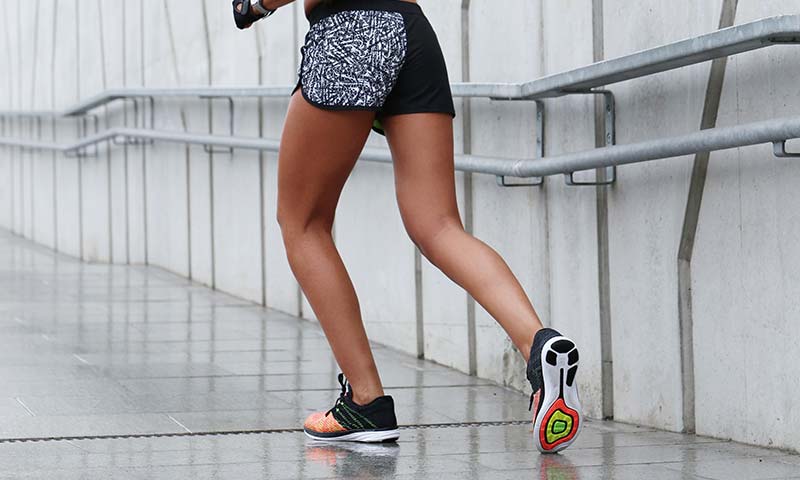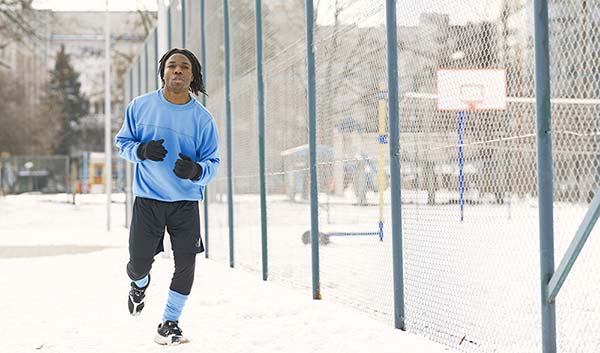There’s nothing worse than looking forward to a good long run only to have Mother Nature junk up your plans.
But while rain or snow will always be an annoyance on a run (unless you just love getting your feet wet), it doesn’t have to be a deterrent.
With a little forward thinking, you can be ready for anything and don’t have to let a little precipitation ruin your running plans.
What to Wear Running in Warm Rain

When you’re running in the rain, your clothes still need to let heat and moisture escape.
This makes for a delicate balance between coverage and breathability.
In warmer weather where the rain won’t make you cold, you can wear exactly what you would wear on a dry-weather run.
Basically, keep clothes synthetic, moisture-wicking and sparse.
What to wear to run in warm rain:
- Running shoes
- Quick-drying, synthetic or wool running socks
- Shorts
- T-shirt or tank top
To ensure you’re comfortable in the rain, you will also want to add:
- A brimmed hat (to keep rain out of your eyes and aid in visibility)
- Ankle gaiters (if you’re super averse to wet socks and feet)
- A light windbreaker or water-resistant running jacket (if you get cold easily)
While it might seem like a good idea to wear waterproof shoes on a rainy run, keep in mind the waterproofing in shoes works both ways.
While waterproof shoes will keep your feet dry from the outside, they also lock in moisture, which can lead to blisters and increase susceptibility to athlete’s foot.
To ensure you’re safe in the rain, you will want to add:
- Reflective clothing or reflectors to your clothing
(It’s our opinion runners sharing a road or path with vehicles or other pedestrians should always wear reflective clothing, but it’s even more essential when skies are dark and visibility is poor.)
These things are all most runners will need to be comfortable and safe in a warm rain.
What to Wear Running in Cold Rain
It’s when the temperature starts to drop that rainy running attire becomes more crucial and bulkier.
Now, you have to worry about keeping both dry and warm.
For the most part, you can accomplish this by wearing the same outfit you might wear when running in cold weather with a few slight additions/variations.
What to wear to run in cold rain:
- Water-resistant running shoes
- Water-resistant running pants
- Lightweight base layer or t-shirt
- Water-resistant running jacket
- Brimmed hat
- Ankle gaiters
- Reflectors
When dressing for a cold-rain run, it’s still important to keep things dry inside, which makes water-resistant running pants and jackets your best line of defense against the elements.
Water-resistant running pants and jackets are made of synthetic, moisture-wicking materials and vented to ensure heat and moisture can escape from your body.
There’s really no adequate substitute when it comes to cold-rain running wear.
While ankle gaiters are associated more with trail running than road and other types of running, they do make gaiters for running shoes that work well to keep water out of your socks/shoes and protect your feet from moisture.
The colder it gets, the more important it becomes to keep your feet dry.
Unless you are out for a very long run, you still won’t need waterproof shoes, but shoes with some water-resistance can go a long way toward making your run more comfortable.
Some water repellant shoes we like for cold-rain runs:
- Brooks Ghost 14 GTX (Men’s)
- Brooks Ghost 14 GTX (Women’s)
- Adidas Ultraboost All Terrain (Men’s)
- Adidas Ultraboost All Terrain (Women’s)
Some running pants we like:
- PULI Men’s Waterproof Outdoor Trousers
- Willit Women’s Outdoor Joggers
- 5Oaks Waterproof Rain Over Pants (as simple as it gets)
Some running jackets we like:
- The North Face Women’s Active Stretch Waterproof Shell Jacket (Women’s)
- THE NORTH FACE Men’s Allproof Stretch Jacket (Men’s)
- Marmot Women’s PreCip Jacket (Women’s)
- Marmot Men’s PreCip Jacket (Men’s)
Some ankle gaiters we like:
What to Wear Running in the Snow

When it comes to stuff that falls out of the sky, snow isn’t much different than a cold rain, and for the most part you can get away with wearing the same thing you wear on a cold rainy run on a snowy run. (Though, you may want a thicker jacket and lined pants.)
Where running in the rain versus running in the snow differ dramatically is at your feet.
Unlike rain, which hits the ground and flows on (ideally), the moisture will always be around your feet when you’re running in the snow.
This makes a water-resistant shoe with better traction essential.
What to wear to run in the snow:
- Trail running shoes
- Running tights/leggings or water-resistant running pants (thermal or lined if you tend to get cold)
- Lightweight to medium-weight base layer
- Water-resistant winter running jacket
- Brimmed hat (if it’s actively snowing)
- Reflectors
Trail Running Shoes
When it comes to good water-resistance and traction on unstable terrain, trail running shoes provide the simplest means of achieving both, making them an ideal solution for running in snow.
Some trail shoes we like for running in snow:
- ALTRA Women’s Lone Peak 6 Trail Running Shoe (Women’s)
- ALTRA Men’s Lone Peak 6 Trail Running Shoe (Men’s)
- Salomon Sense Ride GORE-TEX Invisible Trail-Running Shoes (Women’s)
- Salomon Sense Ride GORE-TEX Invisible Trail-Running Shoes (Men’s)
Water-Resistant Running Jackets and Pants
Just as in the rain, you will also need water-resistance up top if it’s actively snowing. (If the snow is only on the ground, you can skip the water-resistance and just opt for warmer running clothes. If you fall, however, be prepared to get wet.)
Mostly, it’s about dressing for your own comfort, as well as some protection from the elements.
Winter running tights and leggings we like:
- Columbia Storm Surge Pant (Women’s) – pair with leggings
- Columbia Rebel Roamer Pant (Men’s) – pair with tights
- BALEAF Men’s Thermal Fleece Running Tights
- BALEAF Women’s Thermal Fleece Running Tights
Winter running jackets we like:
- Under Armour Women’s ColdGear Reactor Performance Jacket (Women’s)
- Under Armour Men’s ColdGear Reactor Insulated Outdoor Jacket (Men’s)
- BALEAF Men’s Lightweight Puffer Jacket
- BALEAF Women’s Insulated Running Jacket
Get Your Rainy and Wintery Run On
If you’re a runner who prefers the wide-openness of the great outdoors to a treadmill in an enclosed room, you don’t have to force yourself to become an indoor runner just because there’s a little precipitation outside.
Running is an all-weather activity that requires neither clear skies nor warm temperatures.
You might have to wear a few more clothes, you might have to be more careful where you put your feet down, but neither rain nor snow has to stop you from getting out there and putting a few more miles on your running shoes.
Need more in-depth guidance on what to wear when running in cold weather? Check out What to Wear to Run in the Cold.
